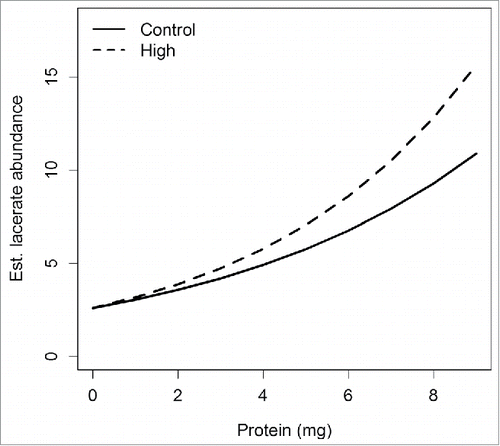Figures & data
Table 1 Treatment groups, sample sizes, and concentrations used during the 21-day exposure period. Abbreviations: BPA = bisphenol A, TBT = tributyltin
Table 2 Number of anemones that produced lacerates and ranges and medians of non-zero number of lacerates produced, average lacerate development time, and protein content of anemones treated for 21 days with seawater, solvent (2% acetone), or low or high doses of tributyltin (TBT), bisphenol A (BPA), or 17 β-estradiol (E2). Low and high doses are defined in
Table 3 AIC model selection results and parameter estimates from binomial-Poisson hurdle models that predict lacerate production of anemones treated with either solvent (2% acetone) or seawater. A) Model selection results are listed in order of increasing AIC values, with the top model (ΔAIC<2) highlighted in bold. Parameter estimates for the B) binomial hurdle and C) Poisson count estimates in the top model are listed, with non-zero estimates (based on 95% confidence intervals) indicated by bullets (•). The binomial hurdle model results predict whether or not anemones will produce lacerates, whereas the Poisson count model results predict the number of lacerates produced among anemones that reproduced. Abbreviations: AIC = Akaike's Information Criterion, k = number of parameters, cum. = cumulative, * = both main effects and interaction were tested, : = only interaction was tested, + = only main effects were tested
Table 4 AIC model selection results and parameter estimates from binomial-Poisson hurdle models that predict lacerate production of anemones treated with either solvent (2% acetone) or low or high concentrations of tributyltin. A) Model selection results are listed in order of increasing AIC values, with the top model (ΔAIC<2) highlighted in bold. Parameter estimates for the B) binomial hurdle and C) Poisson count estimates in the top model are listed, with non-zero estimates (based on 95% confidence intervals) indicated by bullets (•). The binomial hurdle model results predict whether or not anemones will produce lacerates, whereas the Poisson count model results predict the number of lacerates produced among anemones that reproduced. Abbreviations: AIC = Akaike's Information Criterion, k = number of parameters, cum. = cumulative, * = both main effects and interaction were tested, : = only interaction was tested, + = only main effects were tested
Table 5 AIC model selection results and parameter estimates from binomial-Poisson hurdle models that predict lacerate production of anemones treated with either solvent (2% acetone) or low or high concentrations of bisphenol A. A) Model selection results are listed in order of increasing AIC values, with the top models (ΔAIC<2) highlighted in bold. Model-averaged parameter estimates for the B) binomial hurdle and C) Poisson count estimates in the top models are listed, with non-zero estimates (based on 95% confidence intervals) indicated by a bullet (•). The binomial hurdle model results predict whether or not anemones will produce lacerates, whereas the Poisson count model results predict the number of lacerates produced among anemones that reproduced. Abbreviations: AIC = Akaike's Information Criterion, k = number of parameters, cum. = cumulative, * = both main effects and interaction were tested, : = only interaction was tested, + = only main effects were tested
Table 6 AIC model selection results and parameter estimates from binomial-Poisson hurdle models that predict lacerate production of anemones treated with either solvent (2% acetone) or low or high concentrations of 17 β-estradiol (E2). A) Model selection results are listed in order of increasing AIC values, with the top model (ΔAIC<2) highlighted in bold. Parameter estimates for the B) binomial hurdle and C) Poisson count estimates in the top model are listed, with non-zero estimates (based on 95% confidence intervals) indicated by bullets (•). The binomial hurdle model results predict whether or not anemones will produce lacerates, whereas the Poisson count model results predict the number of lacerates produced among anemones that reproduced. Abbreviations: AIC = Akaike's Information Criterion, k = number of parameters, cum. = cumulative, * = both main effects and interaction were tested, : = only interaction was tested, + = only main effects were tested
Figure 1. Effect of exposure to 17 β-estradiol on the estimated number of lacerates produced by anemones across a gradient of anemone protein content. Parent anemones were maintained individually in artificial seawater containing either control (2% acetone) or high dose 17 β-estradiol (45 ng/L) for 21 days, and the number of lacerates produced by each parent anemone was recorded. Lacerate abundance was estimated using binomial-Poisson hurdle models. Data for anemones treated with low dose 17 β-estradiol (1.8 ng/L) were excluded from this plot because parameter estimates for this group overlapped zero.

